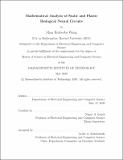| dc.contributor.advisor | Nancy A. Lynch. | en_US |
| dc.contributor.author | Wang, Mien Brabeeba. | en_US |
| dc.contributor.other | Massachusetts Institute of Technology. Department of Electrical Engineering and Computer Science. | en_US |
| dc.date.accessioned | 2020-09-15T21:58:19Z | |
| dc.date.available | 2020-09-15T21:58:19Z | |
| dc.date.copyright | 2020 | en_US |
| dc.date.issued | 2020 | en_US |
| dc.identifier.uri | https://hdl.handle.net/1721.1/127445 | |
| dc.description | Thesis: S.M., Massachusetts Institute of Technology, Department of Electrical Engineering and Computer Science, May, 2020 | en_US |
| dc.description | Cataloged from the official PDF of thesis. | en_US |
| dc.description | Includes bibliographical references (pages 123-129). | en_US |
| dc.description.abstract | In this thesis, I explain possible mathematical principles behind brain computations during the processing of temporal information and fast sensory adaptation using static and plastic neural circuits respectively. For the static part of the thesis, I investigate the possible computational principles behind how the brain can process temporal information over a long time range using neurons with transient activities. Specifically, I design static memoryless neural circuits that are capable of processing temporal sequences in either rate coding or temporal coding and prove that the networks are optimal in both the number of the neurons and the convergence time. For the plastic part of the thesis, I show how a sensory system can potentially adapt quickly under Barlow's efficient coding principle despite having high dimensional sensory inputs. Specifically, I use Oja's rule as an example of sensory adaptation under the efficient coding principle and give the first convergence rate analysis of Oja's rule in solving streaming principal component analysis (PCA). In particular, the convergence rate I obtain matches the information-theoretic lower bound up to logarithmic factors and outperforms the state-of-the-art analysis for other streaming PCA algorithms in the literature. I further demonstrate the capacity of Oja's rule for continual learning in a living system. Specifically, I prove that Oja's rule can continuously adapt to changing environments without sacrificing too much efficiency and remain functional throughout the process. | en_US |
| dc.description.statementofresponsibility | by Mien Brabeeba Wang. | en_US |
| dc.format.extent | 129 pages | en_US |
| dc.language.iso | eng | en_US |
| dc.publisher | Massachusetts Institute of Technology | en_US |
| dc.rights | MIT theses may be protected by copyright. Please reuse MIT thesis content according to the MIT Libraries Permissions Policy, which is available through the URL provided. | en_US |
| dc.rights.uri | http://dspace.mit.edu/handle/1721.1/7582 | en_US |
| dc.subject | Electrical Engineering and Computer Science. | en_US |
| dc.title | Mathematical analysis of static and plastic biological neural circuits | en_US |
| dc.type | Thesis | en_US |
| dc.description.degree | S.M. | en_US |
| dc.contributor.department | Massachusetts Institute of Technology. Department of Electrical Engineering and Computer Science | en_US |
| dc.identifier.oclc | 1192966398 | en_US |
| dc.description.collection | S.M. Massachusetts Institute of Technology, Department of Electrical Engineering and Computer Science | en_US |
| dspace.imported | 2020-09-15T21:58:19Z | en_US |
| mit.thesis.degree | Master | en_US |
| mit.thesis.department | EECS | en_US |
